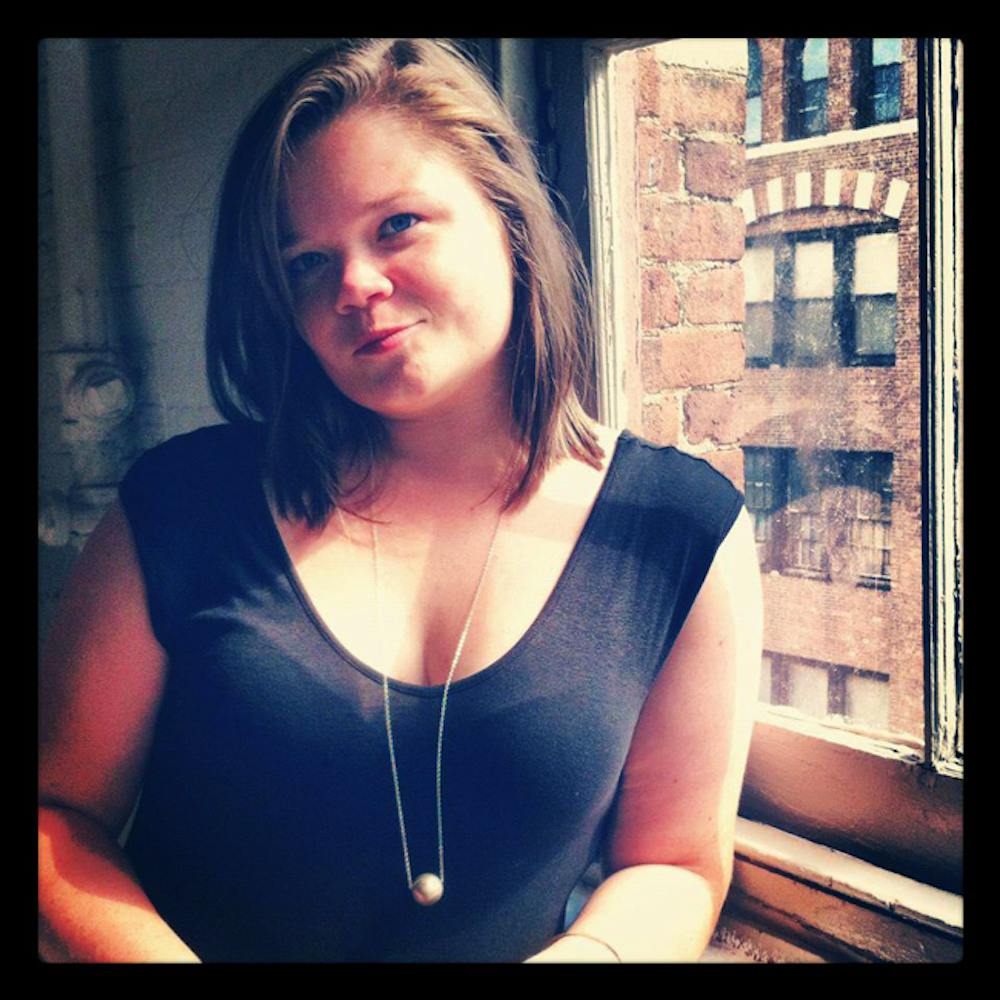Elysa Voshell, C’01, LPS’09 The Artists’ Book Extraordinaire
Elysa Voshell loves to design, create and curate. She makes hand–made artists’ books on her own press, and she also works in printmaking, photography and installation. By day, she helps run Venice Arts, a Los Angeles nonprofit. She serves there as the associate director and she organizes five to seven exhibitions a year as a curator. By night, she’s in her studio, “letterpress printing and binding limited–edition books and prints on my vintage Vandercook Universal I cylinder press,” which she has named “Eleanor.”
Quick Questions:
A favorite exhibition she curated? “Reading in Installments: Book Arts Meets Installation,” a show presented at Philadelphia’s Center for Emerging Visual Artists in 2009 that explored the ways people could interact with book art in an installation format.
Why a handmade book and not a digital tablet? Artist books give people more of a tangible, sensory experience “unfolding over time as the reader turns the page.”
Her favorite thing about arts in the Penn bubble? The natural, intimate community of creative support that exists when Penn students are constantly interacting with both peers and professors. Some of her closest friends are the ones she met in the fine arts studios, “back when they were housed in a blue, barnlike structure on the edge of campus called the Blauhaus.”
Other favorite Penn spots? The print shop in the Morgan building or the darkrooms in Addams Hall.
Her favorite thing about arts in the real world? Seeing the big (and deep) projects that can flourish when not restricted to a semester’s timeframe.
William Blueher, SAS’07 Keeper of the Met’s Chamber of Secrets
After earning his masters in English literature from Penn, William went on to become a librarian at debatably the greatest American art museum: the Metropolitan Museum of Art in New York City. William spends a typical day absorbed in the collections of the Thomas J. Watson Library of the Met, a world–renowned research collection with over 800,000 volumes located just south of Met’s main stairs. He digitalizes physical books and artworks so that they can be more accessible for future use. And, though he works with the full spectrum of written cultural material—European, American, ancient Near Eastern, Egyptian, Greek, Roman, Asian and Islamic art—he doesn’t neglect the actual artworks housed in the Met. He gets “to pass through the Great Hall a few times a day, and I make it a point to explore new exhibitions at least once a week.”
Quick Questions:
Favorite Penn library? Fisher Fine Arts.
Favorite non–Penn library? The New York Public Library— “it is unrivaled.”
A piece of advice to an aspiring librarian in the arts and humanities? Try to get involved early—look for volunteer or internship opportunities to see if librarianship is something you’re really interested in.
Catherine Turcich-Kealey, C’08 The Museum Devotee
Catherine works at the Philadelphia Museum of Art, where she currently assists in researching the museum’s audiences. She's held positions at the Academy of Natural Sciences at Drexel, the Delaware Art Museum and Philly’s Mutter Museum, after working as an exhibitions assistant for Penn’s Rare Books and Manuscripts Library, now on Van Pelt’s sixth floor. Catherine believes in the power of the museum to create conversations with its visitors. And technological advances play a role in this, too, as she cited how, “for a very long time, museums have put an emphasis on preservation and tradition—holding tight to their modernist belief of a single authority,” but that now with new digital and social media, “there is no one experience or truth.”
Quick Questions:
Things she thinks about when putting together a museum show? The content of the exhibition, the institutional mission and its intended audience.
An especially memorable experience? Mummifying a human foot while working at the Mütter Museum.
Favorite museum outside of the Penn bubble? The Eastern State Penitentiary.
Favorite museum inside the Penn bubble? The Institute of Contemporary Art, where “they have been killing it since 1963.”
Eric Johnson, C’94 The Medieval Manuscript Expert
Eric works on rare medieval books and manuscripts, a passion that flourished when he was at Penn. Working hands–on with rare texts allows him to immediately connect with the past and learn about “the infinite variety of ways that people have devised to communicate their ideas—from the mundane and perverse to the transformational and sublime—throughout history.” He also loves the physical quality of a book: “its binding, the paper or parchment pages that bear its text, the evidence left behind by past readers in the form of marginal notes, excisions, pen-trials, and inscriptions.”
The Fast Facts:
Favorite place in the Penn library system? The medieval studies seminar room in Van Pelt overlooking Walnut Street.
Favorite department in any library? Any rare and special collections.
Thoughts on the relevance of arts and humanities? The arts and humanities make life worth living. Or, to put it another way, what’s a STEM without the flower it supports?
A piece of advice to an aspiring academic in the arts and humanities? Be enthusiastic, learn to be flexible and prepare yourself to be an ambassador for the eternal value and importance of the arts and humanities—and have fun while you’re doing it!

